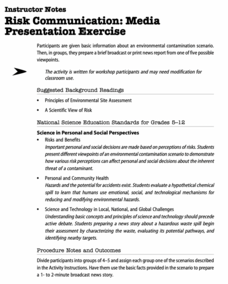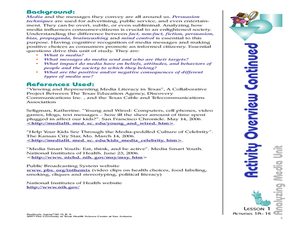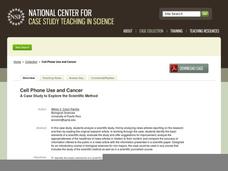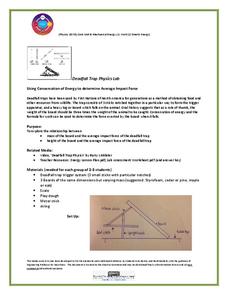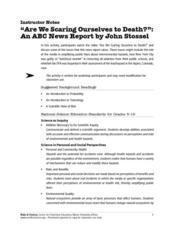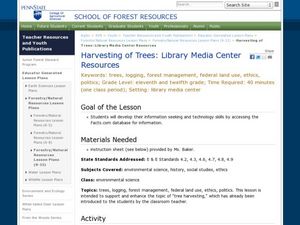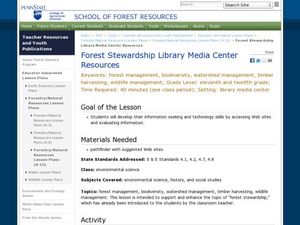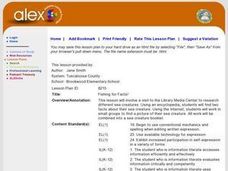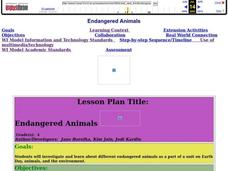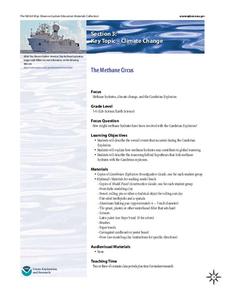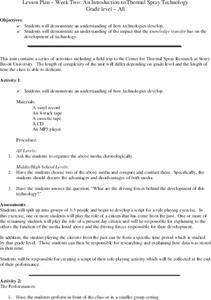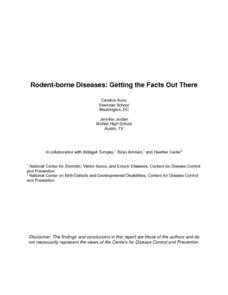Curated OER
Risk Communication: Media Presentation Exercise
Students work in groups to prepare a brief broadcast or print news report from one of five possible viewpoints about an environmental contamination scenario. Students are given basic information about a chemical spill in a small town and...
Curated OER
Mixed Media Messages: Reduce, Reuse, Recycle
Students examine the process of recycling by creating a mock television commercial about recycling. In this recycling lesson, students watch an animated demonstration about recycling and answer content questions. Students play an online...
Curated OER
Analyzing Media Unit Sequence of Five Activities
Seventh graders define terminology and explore the effects media has on our society and on individuals. In this media evaluation lesson plan students work cooperatively and solve problems.
National Wildlife Federation
Quantifying Land Changes Over Time Using Landsat
"Humans have become a geologic agent comparable to erosion and [volcanic] eruptions ..." Paul J. Crutzen, a Nobel Prize-winning atmospheric chemist. Using Landsat imagery, scholars create a grid showing land use type, such as urban,...
National Center for Case Study Teaching in Science
Cell Phone Use and Cancer
The cell phone you're using is making you deaf: news at 11:00. Oftentimes, the media uses fear tactics and other techniques to increase its audience base. In an intriguing look at the difference between scientific journals and...
Curated OER
Full Circle Advertising: A Look at Teen Alcohol Use and Fetal Alcohol Syndrome
High schoolers analyze ads and learn about the effects of alcohol. Note that the PowerPoint mentioned in the procedure is not included, so you will need to prepare your own presentation. After the lecture, segue into fetal alcohol...
University of Saskatchewan
Using Conservation of Energy to Determine Average Impact Force
Explore the center of gravity with your science class as they create a deadfall trap with common materials. They research the concepts of energy conservation and gravitational force before dividing into small groups to create a model of...
Curated OER
Are We Scaring Ourselves to Death?
Interesting! Have your high schoolers watch this 13-minute clip from the documentay, "Are We Scaring Ourselves to Death?" It examines the fear we have as a culture about death and whether or not the media increases those fears. The focus...
Curated OER
Harvesting of Trees: Library Media Center Resources
Students research harvesting of trees in the United States and write a summary. In this informative lesson plan students state whether they agree or disagree with an article and write a summary on why.
Curated OER
From the Mouths of Space Scientists: An Introduction to Space and Weather
After researching the Greenland Space Science Symposium, curious thinkers create a PowerPoint or video presentation. They use the information they gathered to construct their presentation.
Curated OER
Forest Stewardship Library Media Center Resources
Students develop their technology skills by accessing web sites and evaluating information. In this research lesson students research forestry topics and write a paragraph on the accessed websites.
Curated OER
Fishing for Facts!
First graders visit the library or media center to research sea creatures using encyclopedia. They find two facts and research the Internet to find a picture of the sea creature. They create a class sea creature booklet.
Curated OER
Hamlet Research Paper: Find, Evaluate, and Select Appropriate Research Sources
Help young researchers find credible sources online. Modeling with a Google search for information about Shakespeare’s Macbeth, use a computer projector or Smart Board to show class members how weak the top three search results are....
National Institute of Open Schooling
Solid State
Crystal comes from a Greek word meaning ice. Activity eight in a series of 36 has class members analyzing amorphous and crystalline solids and further classifying them based on their forces. They then explore solids, learning about unit...
Curated OER
The Galapagos Spreading Center
Learners explore the basic concept of seafloor spreading. They describe the processes involved in creating new seafloor at a mid-ocean ridge. They investigate the Galapagos Spreading Center system.
Curated OER
Endangered Animals
Fourth graders research different endangered animals in media center as part of unit on Earth Day, animals, and environment, create project based around multiple intelligence related to an endangered animal, and produce Powerpoint...
NOAA
The Methane Circus
Step right up! An engaging research-centered lesson, the third in a series of six, has young archaeologists study the amazing animals of the Cambrian explosion. Working in groups, they profile a breathtaking and odd creature and learn...
Discovery Education
Sonar & Echolocation
A well-designed, comprehensive, and attractive slide show supports direct instruction on how sonar and echolocation work. Contained within the slides are links to interactive websites and instructions for using apps on a mobile device to...
Research Parent
Solar System Cards
Find all things solar system in a set of reference cards. Even Pluto makes an appearance! Each of the 24 cards has a picture and accompanying informational text that gives brief background about the object.
Curated OER
Where Did They Come From?
Give science learners nine questions about the biogeography of hydrothermal vents and turn them loose to research this fascinating habitat. Working in cooperative groups, they prepare a report that addresses each of the questions. A...
Curated OER
An Introduction to Thermal Spray Technology
Students investigate the development of technology from a historical perspective. They order different technologies according to timing of development and use. Then students role play the use of each piece of equipment in hypothetical...
Curated OER
Rodent-borne Diseases: Getting the Facts Out There
High schoolers conduct research of the hantavirus pulmonary syndrome (HPS) or lymphocytic choriomeningitis (LCMV). They obtain the information and create a public announcement in the form of a brochure, newsletter, poster, radio...
Curated OER
Acrobatic Clown
In this science investigation instructional activity, students learn about balancing points and center of gravity by making a cardboard acrobatic clown using the directions and pattern provided.
Curated OER
The Biggest Plates on Earth
The best part about teaching guides is all the great information you can use to inform your class. They infer what type of boundary exists between two tectonic plates. Then, using given information on earthquakes and volcanism they'll...
